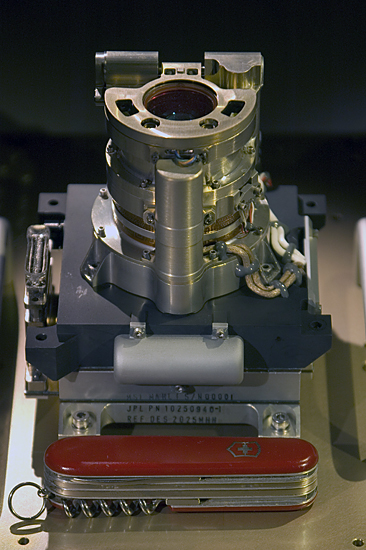Mars Science Laboratory (MSL)
Mars Hand Lens Imager (MAHLI)
Instrument Description

The Mars Hand Lens Imager (MAHLI) camera head.
The knife is 88.9 mm (3.5 inches) long.
Image credit: Malin Space Science Systems
|
The Mars Hand Lens Imager (MAHLI) will be mounted on the turret at the
end of the MSL robotic arm. Its purpose is to acquire close-up images of
materials on the martian surface—rocks, fines, and frost.
It will be used to help characterize the geology of the site
investigated by MSL, and it will be used to document the
materials being examined by MSL’s geochemical and mineralogical
experiments.
The Mars Exploration Rovers (MER), Spirit and Opportunity, each
carried a Microscopic Imager (MI). The MI images resulted in
a revolution in Mars science, permitting geologists to see
martian surface materials at a scale that was not available
on previous Mars missions. For the first time, MI images
confirmed the presence of sand-sized grains (sand is defined
by geologists as grains of 62.5 to 2000 micrometers in size)
on Mars. Sand was long suspected but not confirmed to occur
on Mars until the 2004 missions acquired MI data. The MI
instruments and subsequent high resolution cameras onboard the
Phoenix lander have greatly contributed to the understanding of
the geology and geologic history of their landing sites on Mars.
The basic characteristics of MAHLI are as follows:
- MAHLI consists of two hardware elements: a camera
head, mounted on the MSL robotic arm, and a Digital Electronics Box (DEA),
which also contains the electronics for the Mars Descent Imager (MARDI) and
two Mast Cameras (Mastcam). The DEA is housed in a temperature-controlled
environment inside the rover.
- MAHLI shares common elements in terms of design, parts,
and labor, with the other MSSS cameras for MSL, the
MastCam and
MARDI.
- MAHLI uses a
Bayer Pattern Filter
CCD to obtain natural
color pictures of a quality like that of commercial
digital cameras. Most color systems flown to Mars previously
require at least 2 or 3 images acquired by looking through
different visible light filters to obtain color, and then
there is always the inevitable question, “Is this what the
human eye would see?” With MAHLI, Mastcam, and MARDI,
the Bayer Pattern Filter CCD array permits an answer to
this question, an answer of “Yes.” For MAHLI, specifically,
having color provides an improvement for the geologists’
ability to interpret the mineralogy of the material being studied.
- The CCD used by MAHLI is 1600 by 1200 pixels
in size. MAHLI uses all 1600 by 1200 pixels for each
color image. In other words, MAHLI is a 2 Megapixel camera.
- MAHLI has a motor that allows the position of the lenses
to be adjusted, so that the camera can focus on its target.
The camera can focus at working distances (the distance between the
target and the front lens element) of 22.5 mm (0.9 inch) and infinity.
- At close focus (22.5 mm), images will have a resolution of about 15 micrometers (0.0006 inch)
per pixel and cover an area of about 18 by 24 mm (0.7 by 0.9 inch).
At a working distance of 50 mm (nearly 2 inches), images will have a resolution of about 24.5 micrometers
(0.001 inch) per pixel. At the distance which the MER MI takes pictures, 66 mm (2.6 inches), the resolution
is about the same as MI (31 micrometers per pixel), but the pictures cover a larger area and are in color.
- MAHLI can acquire multiple images of the same feature at different focus positions and use this to
build a best-focus image and a range map of the target. This process is sometimes called z-stacking or
focal plane merging.
- MAHLI has 4 white light LEDs and 2 ultraviolet (365 nanometers)
LEDs to provide illumination of the targets at night or in deep shadow.
Each of the two sets of white light LEDs can be turned on/off independently of the other.
The ultraviolet LEDs provide an opportunity
to look for fluorescent minerals.
- Because MAHLI can focus at infinity, in addition to
being able to get microscopic views of surface materials
MAHLI can also be used for other purposes, including inspection of areas on the
rover or imaging the local landscape.
- Stereo (3-d) views of selected targets can be acquired
by taking 2 images of a target from different looking angles.
This is achieved by moving the robotic arm to place the
camera in the two different positions.
- MAHLI has a dust cover to protect the optics from becoming
coated by fine dust and dirt. The dust cover has a window through which pictures can be
taken if necessary. The camera can focus and take pictures whether the dust cover is open
or closed.
© 2008 by Malin Space Science Systems, Inc.


